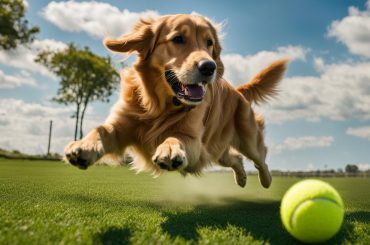Teaching your dog to shake paws is a fun and rewarding experience that can deepen the bond between you and your furry friend. It’s a relatively easy trick that most dogs can learn quickly with the right approach. In this guide, I will walk you through the simple steps of teaching your dog to shake paws using positive reinforcement training techniques.
Key Takeaways:
- Teaching your dog to shake paws is an enjoyable way to engage with them and stimulate their minds.
- Positive reinforcement training is an effective method to teach dogs new tricks, including shaking paws.
- Start with the basics by ensuring your dog knows the sit command reliably before moving on to shake training.
- Use treats or a clicker as rewards during training sessions to motivate your dog and reinforce desired behavior.
- Be patient, consistent, and focus on short, frequent training sessions to achieve success in teaching your dog to shake paws.
The Basics of Shake Training
To successfully teach your dog to shake paws, I would advise that you understand the basics of shake training. This type of canine behavior can be achieved through positive reinforcement training, which emphasizes rewarding desired behaviors rather than punishing unwanted ones. By following a few simple steps and maintaining consistency, you’ll be able to teach your dog this fun and impressive trick.
Before starting shake training, ensure that your dog is familiar with the sit command. This is an important prerequisite as shake training requires your dog to sit calmly and pay attention to your instructions. Additionally, gather a handful of treats or a clicker if you prefer clicker training as a reward for your dog’s successful attempts.
With your dog in a sitting position, hold a treat in one hand and close your fist over it. Present this closed fist to your dog and give the command “shake.” Wave your hand under your dog’s nose to keep them engaged and interested in the treat. As your dog naturally starts pawing at your hand, say “good” or use a clicker to mark the desired behavior and open your hand to allow them to have the treat. Repeat these steps in short sessions, two or three times a day, gradually reducing the need to hold the treat in your closed hand.
| Benefits of Shake Training | Challenges of Shake Training |
|---|---|
|
|
Why Shake Training is Beneficial
Shake training offers various benefits for both you and your dog. Firstly, it helps strengthen the bond between you and your furry companion, as it requires trust and cooperation. Additionally, shake training provides mental stimulation for your dog, keeping their mind active and engaged. Finally, teaching your dog to shake paws can be a delightful way to showcase their intelligence and impress friends and family.
While shake training is generally straightforward, acknowledge the challenges that may arise. Some dogs may be sensitive about having their paws touched, requiring a gradual approach to build their comfort and confidence. Additionally, each dog learns at their own pace, so the rate of progress may vary. Lastly, distractions during training sessions can make it more challenging for your dog to focus. By being patient, understanding, and adjusting your training techniques as needed, you can overcome these challenges and successfully teach your dog to shake.
Step-by-Step Guide: Teaching Your Dog to Shake
To teach your dog to shake, follow these simple steps:
- Step 1: Have your dog sit.
- Step 2: Hold a treat in one hand and show it to your dog.
- Step 3: Close your fist over the treat.
- Step 4: Give the command “shake” and wave your closed fist under your dog’s nose to keep them interested in the treat.
- Step 5: Wait for your dog to start pawing at your hand.
- Step 6: The moment your dog touches your hand with its paw, say “good” or click your clicker and open your hand to allow your dog to have the treat.
Repeat this process for short training sessions, two or three times a day. Gradually phase out the need to hold the treat in your closed hand by offering the treat from your other hand when your dog offers their paw. Continue practicing and reinforcing the behavior until your dog is consistently offering their paw on command.
Common mistakes to avoid:
- Avoid forcing your dog’s paw into your hand, as this can create negative associations with the behavior.
- Don’t get frustrated if your dog doesn’t learn the trick immediately. Each dog learns at their own pace, so be patient and consistent in your training.
- Avoid using punishment or harsh corrections during the training process, as it can hinder the learning experience and damage the bond between you and your dog.
To put it simply, positive reinforcement training is the key to success. Use treats, praise, and other rewards to encourage and motivate your dog throughout the training sessions. With time and practice, your dog will master the shake command and impress everyone with their paw-shaking skills!
| Step | Instruction |
|---|---|
| Step 1 | Have your dog sit. |
| Step 2 | Hold a treat in one hand and show it to your dog. |
| Step 3 | Close your fist over the treat. |
| Step 4 | Give the command “shake” and wave your closed fist under your dog’s nose to keep them interested in the treat. |
| Step 5 | Wait for your dog to start pawing at your hand. |
| Step 6 | The moment your dog touches your hand with its paw, say “good” or click your clicker and open your hand to allow your dog to have the treat. |
Troubleshooting: Common Problems in Shake Training
During the process of teaching your dog to shake paws, you may encounter some common problems. Here are a few troubleshooting tips to help you overcome these challenges:
1. Paw reluctance:
Some dogs may be hesitant or resistant to offering their paw. If your dog is reluctant to shake, try these strategies:
- Use high-value treats or rewards to motivate your dog.
- Start by offering your hand without asking for a shake, and reward any voluntary paw movement.
- Gradually shape the behavior by rewarding your dog for touching your hand with their paw.
2. Incorrect paw:
Your dog may offer the wrong paw during shake training. Instead of correcting them, be patient and wait for them to offer the desired paw naturally. Reward and reinforce the correct behavior when it occurs.
3. Paw sensitivity:
Some dogs may have sensitive paws, making shake training more challenging. If your dog shows signs of discomfort, such as pulling away or trembling, be gentle and go at their pace. Start by touching their paw lightly and gradually increase pressure over time. Always reward and praise them for their efforts.
To put it simply, troubleshooting common problems in shake training requires patience and understanding. Each dog is unique, and it may take time for them to master the trick. Stay consistent, use positive reinforcement, and adapt your training approach to suit your dog’s individual needs.
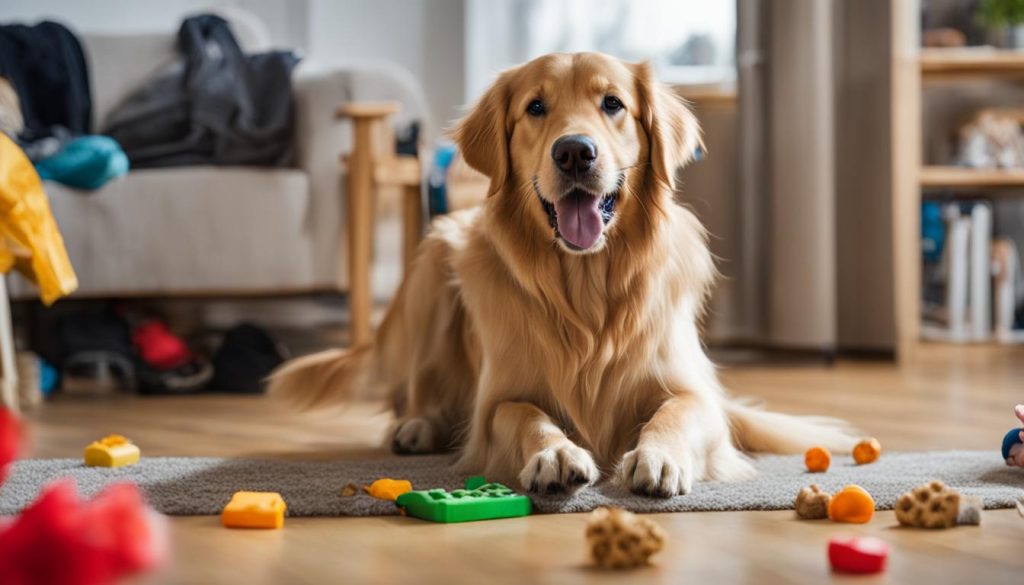
Proofing the Behavior: Moving Beyond Training
Once your dog has mastered the shake paw command, you should proof the behavior in various settings and with different people. This will help your dog generalize the command and understand that shaking paws is a behavior that should be performed regardless of the circumstances.
To proof the behavior, start by having another person ask your dog to shake. Before they do, demonstrate the approach yourself so that the person can mimic your actions as closely as possible. This will provide consistency and clarity in the training process. Allow the person to sit the dog down and ask for a shake. When your dog performs the behavior correctly, make sure to praise and reward them.
Repeat this exercise with different people to reinforce the concept that shaking paws is a behavior that should be performed for anyone who asks. By practicing this with a variety of individuals, your dog will become more comfortable and confident in performing the trick. Try to always end training sessions on a positive note and be patient as your dog becomes more proficient in the behavior.
Benefits of proofing the behavior:
- Increased reliability: By proofing the behavior, you are ensuring that your dog will shake paws regardless of the context or person asking for the behavior.
- Enhanced socialization: Through exposure to different people, your dog will become more comfortable and sociable, improving their overall behavior in social situations.
- Generalization of the command: Proofing the behavior helps your dog understand that the command is not limited to a specific person or location, but rather a behavior to be performed in various circumstances.
By consistently proofing the behavior, you are setting your dog up for success and ensuring that the shake paw trick becomes a reliable and impressive skill. Try to have patience and celebrate your dog’s progress along the way.
| Benefits of Proofing the Behavior |
|---|
| Increased reliability |
| Enhanced socialization |
| Generalization of the command |
Teaching Shake with Both Paws
Teaching your dog to shake with both paws can be a bit more challenging than teaching them to shake with just one paw. Dogs don’t naturally generalize the behavior, so train each paw separately. The process is similar to teaching shake with one paw, but with a few adjustments.
Start by using the same steps as before, but this time, only reward and praise your dog when they offer to shake with the paw closest to your hand. If they offer the “wrong” paw, simply wait quietly until they offer the correct one, and then reward them. By reinforcing the behavior you want, you’ll help your dog understand that each paw can be used to shake.
Repeat this process for each paw, ensuring that your dog learns to shake with both paws consistently. It may take some time and patience, but with consistency and positive reinforcement, your dog will eventually understand the concept of shaking with both paws.
| Paw | Steps |
|---|---|
| Right Paw | Hold treat, wait for paw offer, reward |
| Left Paw | Hold treat, wait for paw offer, reward |
| Both Paws | Use “shake” command, wait for paw offers, reward |
To put it simply, patience is key during the training process. Avoid correcting or chastising your dog if they don’t offer the correct paw right away. Instead, wait for the desired behavior and reward it. By staying positive and consistent, you’ll help your dog become a pro at shaking with both paws.
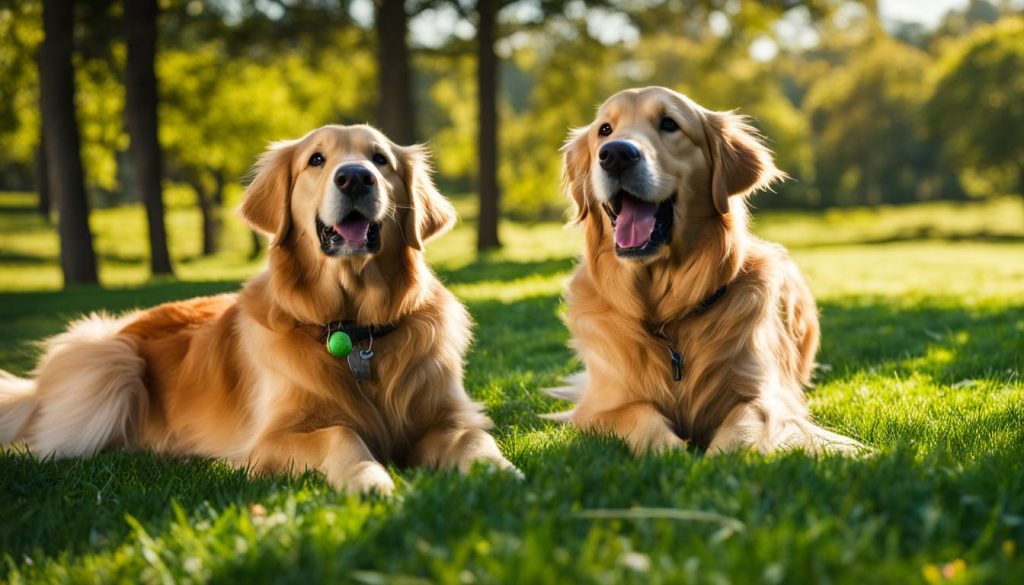
Tips for Success: Focus and Consistency
When it comes to teaching your dog to shake paws, focus and consistency are key to success. By following these tips, you can ensure that your training sessions are effective and enjoyable for both you and your furry friend.
Set aside dedicated training time
To effectively teach your dog to shake paws, set aside dedicated training time. Aim for short and frequent sessions, as dogs have shorter attention spans. This will help keep your dog engaged and prevent them from getting bored or frustrated.
Use high-value rewards
Positive reinforcement training relies on rewarding your dog for good behavior. When it comes to shake training, use high-value treats or rewards that your dog loves. This will motivate them to perform the desired behavior and make the training process more enjoyable for both of you.
Be patient and consistent
Teaching your dog a new trick takes time and patience. Be consistent with your training methods and cues, using the same commands and gestures each time. Reinforce the behavior with rewards and praise consistently. To put it simply, dogs learn at their own pace, so be patient and understanding throughout the process.
Make it fun and end on a positive note
Training should be a fun and positive experience for both you and your dog. Use a cheerful tone and body language to make the training sessions enjoyable. Always end on a positive note, even if it means asking your dog to perform a simple command like sit. Celebrate your dog’s progress and achievements along the way to keep their motivation high.
| Tips for Success: Focus and Consistency |
|---|
| Set aside dedicated training time |
| Use high-value rewards |
| Be patient and consistent |
| Make it fun and end on a positive note |
Troubleshooting: Paw Sensitivity
If your dog shows signs of paw sensitivity during shake training, approach the situation with extra care and patience. Some dogs may be uncomfortable or even fearful of having their paws touched, which can pose a challenge when teaching them to shake. Here are some tips to help you navigate this obstacle and continue training your dog effectively:
- Be patient: Understand that it may take longer for a sensitive dog to overcome their discomfort with paw handling. Take your time and go at their pace, allowing them to gradually build confidence and trust.
- Desensitization: Start by gently touching your dog’s paws during regular petting or grooming sessions. Offer treats and positive reinforcement to create a positive association with paw handling.
- Positive reinforcement training: Continue using positive reinforcement techniques throughout the training process. Reward your dog for any progress they make, even if it’s a small step. This will motivate them to continue trying.
- Respect boundaries: If your dog is showing clear signs of distress or discomfort, respect their boundaries and take a step back. Give them time to relax and try again later.
To put it simply, every dog is unique, and tailor your training approach to their individual needs. If your dog continues to struggle with paw sensitivity, consider consulting a professional dog trainer or behaviorist for additional guidance and support.
By approaching paw sensitivity with patience, understanding, and positive reinforcement, you can help your dog overcome their fears and successfully teach them to shake paws. The key is to create a safe and supportive environment that allows your dog to feel comfortable and confident during the training process.
| Common signs of paw sensitivity: | How to help your dog overcome paw sensitivity: |
|---|---|
| 1. Moving away when you touch their paws | 1. Gently desensitize your dog by touching their paws during regular petting sessions |
| 2. Avoiding eye contact | 2. Use positive reinforcement to create a positive association with paw handling |
| 3. Trembling or shaking | 3. Respect your dog’s boundaries and give them time to relax if they show signs of distress |
To put it simply, paw sensitivity can vary from dog to dog, and I would advise that you be patient and understanding throughout the training process. With time and positive reinforcement, your dog can overcome their sensitivity and confidently master the shake paws trick.
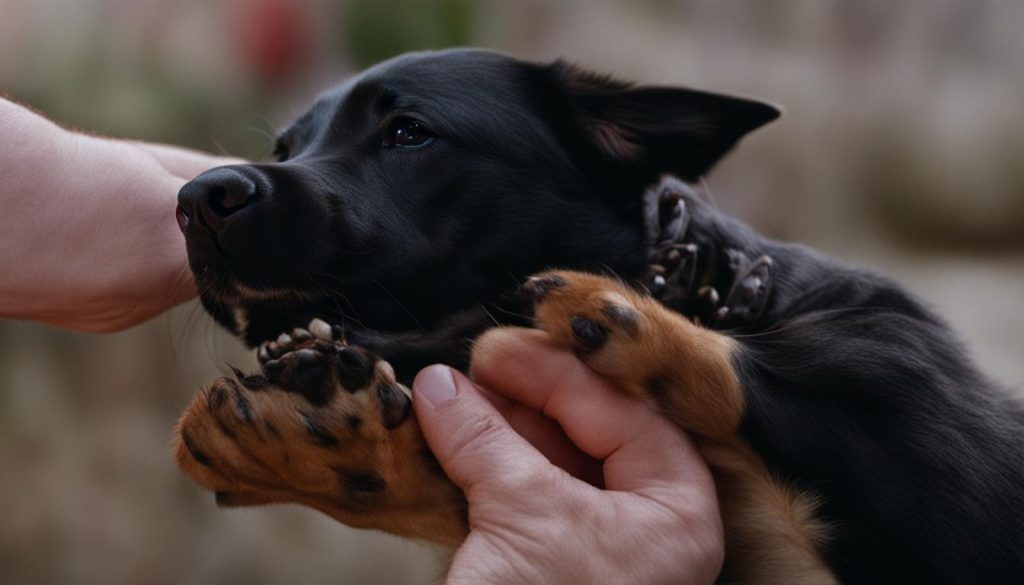
Adding Verbal Cues
Once your dog has mastered the paw shake command, you can take the training a step further by adding a verbal cue. This will allow you to give a command without needing to present your hand every time. Adding a verbal cue to the trick will enhance your dog’s understanding and response to the command.
To add a verbal cue, choose a word or phrase that you will consistently use when asking your dog to shake paws. Examples include “shake,” “paw,” or any other word that you find suitable. You should select a cue that is short, clear, and easy to pronounce. Say the verbal cue just before presenting your hand for shaking.
Try to use the verbal cue consistently every time you want your dog to shake paws. With repetition and reinforcement, your dog will soon associate the verbal cue with the action of offering their paw. Be patient and consistent, and your dog will confidently respond to the verbal cue.
Using a verbal cue in combination with the hand signal will make it easier for you to give commands in different situations and from a distance. This flexibility is especially useful when you want your dog to perform the trick without physically being in front of them. Make sure to practice the verbal cue in various scenarios to reinforce your dog’s understanding of the command.
Benefits of Adding a Verbal Cue
Adding a verbal cue to the paw shake trick has several benefits. Firstly, it increases the reliability of your dog’s response to the command. With a clear and consistent verbal cue, your dog will understand what is expected of them, even without seeing your hand motion. Secondly, it enhances the communication between you and your dog, allowing for smoother interactions and easier training sessions. Lastly, it adds an extra layer of fun and engagement to the trick, making it more exciting for both you and your dog.
Summary
Adding a verbal cue to the paw shake trick is a great way to enhance your dog’s understanding and response to the command. Choose a short and clear word or phrase, consistently use it when asking your dog to shake paws, and practice in different scenarios to reinforce their understanding. The addition of a verbal cue will increase the reliability of your dog’s response and make the trick more enjoyable for both of you.
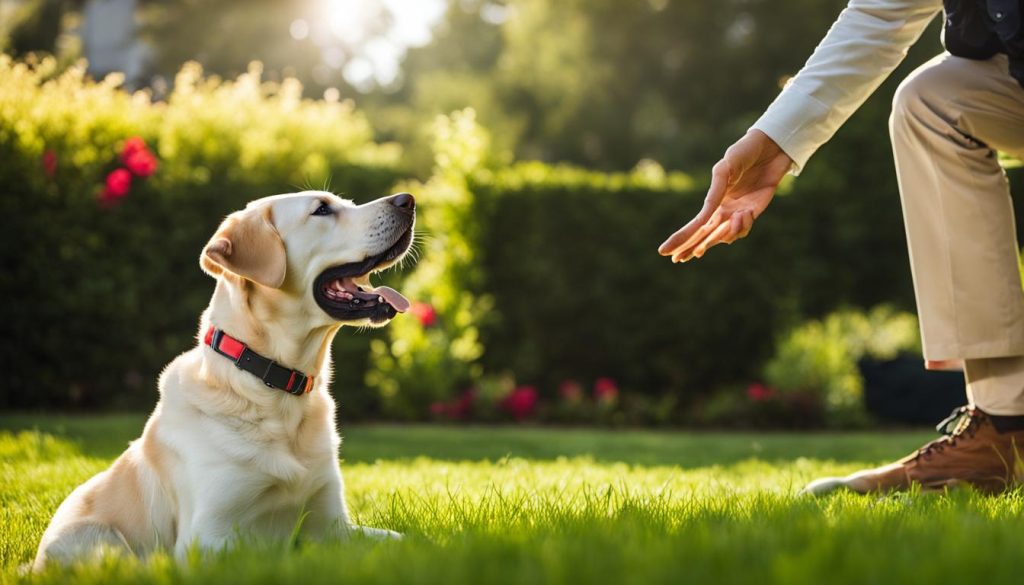
Advancing to High-Fives and More
Now that your dog has mastered the shake command, it’s time to take their trick repertoire to the next level. One fun and impressive trick to teach is the high-five. This trick adds a playful and interactive element to your dog’s training and provides an opportunity for them to showcase their intelligence and coordination.
To teach your dog to do a high-five, start by holding your hand with your fingers pointed upwards, similar to how you would position your hand for a handshake. Give the command “shake” or “high-five” and wait for your dog to lift their paw to touch your hand. As soon as their paw makes contact with your hand, praise them and give them a treat as a reward. Repeat this process, gradually shaping the behavior so that your dog’s paw movement resembles a high-five motion.
Try to use positive reinforcement throughout the training process. Reward your dog for their efforts and progress, and be patient if they struggle to understand the new command at first. Breaking down the trick into small, achievable steps will help your dog grasp the concept and build their confidence. With consistent practice and reinforcement, your dog will soon be offering high-fives on command.
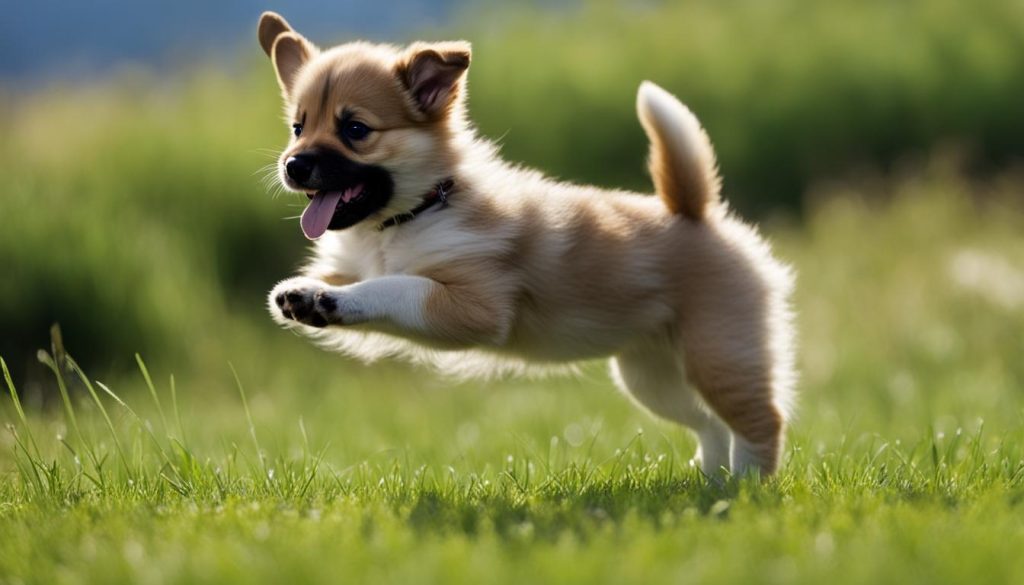
“Teaching your dog new tricks not only provides mental stimulation, but it also strengthens the bond between you and your furry companion. High-fives are a great way to showcase your dog’s intelligence and create a fun and interactive experience for both of you.”
Final Thoughts
Teaching your dog tricks through positive reinforcement training can be a fulfilling and enjoyable experience. With a focus on dog training, teaching tricks to dogs, and using positive reinforcement methods, you can foster a strong bond with your furry friend while also stimulating their mental and physical well-being.
Throughout this article, we’ve explored the step-by-step process of teaching your dog to shake paws. By following the basics of shake training, patiently guiding your dog through each step, and troubleshooting common problems, you can successfully teach them this impressive trick.
Try to stay consistent, keep training sessions short and frequent, and always end on a positive note. Gradually, you can progress to adding verbal cues and advance to more complex tricks, such as high-fives. The key is to maintain a positive and encouraging approach, celebrating your dog’s progress along the way.
So, grab some treats, set aside some time, and embark on this wonderful journey of teaching your dog tricks. With the right techniques and a whole lot of love, you and your canine companion can achieve great things together through positive reinforcement training.
FAQ
Can any dog learn to shake paws?
Most dogs can learn to shake paws with proper training and patience.
What supplies do I need to teach my dog to shake?
You will need treats or a clicker for training, and make sure your dog knows the sit command reliably.
How do I start teaching my dog to shake?
Begin by having your dog sit, then show them a treat in your closed fist and give the command “shake.”
How often should I train my dog to shake?
Aim for short training sessions of two or three times a day.
What if my dog doesn’t understand the shake command?
Try moving your hand closer to their paw or gently encouraging the behavior before lifting their paw into your hand yourself.
How can I proof the shake behavior?
Have other people ask your dog to shake, demonstrating the approach themselves, to reinforce the concept.
Should I teach my dog to shake with both paws?
Yes, to teach your dog to shake with both paws, you may need to teach each paw separately.
What if my dog is sensitive about having their paws touched?
Be extra careful and go at their pace, letting their paw touch your hand instead of reaching for it, and rewarding their efforts.
When should I add a verbal cue to the shake command?
Once your dog consistently offers their paw in response to the hand signal, you can start adding a verbal cue.
How can I teach my dog other tricks after shake training?
Once your dog has mastered shake, you can move on to teaching them other tricks, such as high-fives, by shaping the behavior into small achievable steps.
What is the key to success in training my dog to shake paws?
Stay focused and consistent, use high-value treats or rewards, and keep training sessions fun and engaging.




